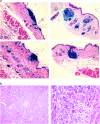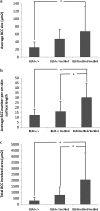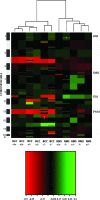Loss of Blm enhances basal cell carcinoma and rhabdomyosarcoma tumorigenesis in Ptch1+/- mice
- PMID: 19995795
- PMCID: PMC2878356
- DOI: 10.1093/carcin/bgp309
Loss of Blm enhances basal cell carcinoma and rhabdomyosarcoma tumorigenesis in Ptch1+/- mice
Abstract
Basal cell carcinomas (BCCs) have relative genomic stability and relatively benign clinical behavior but whether these two are related causally is unknown. To investigate the effects of introducing genomic instability into murine BCCs, we have compared ionizing radiation-induced tumorigenesis in Ptch1(+/-) mice versus that in Ptch1(+/-) mice carrying mutant Blm alleles. We found that BCCs in Ptch1(+/-) Blm(tm3Brd/tm3Brd) mice had a trend toward greater genomic instability as measured by array comprehensive genomic hybridization and that these mice developed significantly more microscopic BCCs than did Ptch1(+/-) Blm(+/tm3Brd) or Ptch1(+/-) Blm(+/+) mice. The mutant Blm alleles also markedly enhanced the formation of rhabdomyosarcomas (RMSs), another cancer to which Ptch1(+/)(-) mice and PTCH1(+/)(-) (basal cell nevus syndrome) patients are susceptible. Highly recurrent but different copy number changes were associated with the two tumor types and included losses of chromosomes 4 and 10 in all BCCs and gain of chromosome 10 in 80% of RMSs. Loss of chromosome 11 and 13, including the Trp53 and Ptch1 loci, respectively, occurred frequently in BCCs, suggesting tissue-specific selection for genes or pathways that collaborate with Ptch deficiency in tumorigenesis. Despite the quantitative differences, there was no dramatic qualititative difference in the BCC or RMS tumors associated with the mutant Blm genotype.
Figures




Similar articles
-
Basal cell carcinoma and its development: insights from radiation-induced tumors in Ptch1-deficient mice.Cancer Res. 2004 Feb 1;64(3):934-41. doi: 10.1158/0008-5472.can-03-2460. Cancer Res. 2004. PMID: 14871823
-
Modulation of patched-associated susceptibility to radiation induced tumorigenesis by genetic background.Cancer Res. 2004 Jun 1;64(11):3798-806. doi: 10.1158/0008-5472.CAN-03-3716. Cancer Res. 2004. PMID: 15172986
-
Genomic profiling of late-onset basal cell carcinomas from two brothers with nevoid basal cell carcinoma syndrome.J Eur Acad Dermatol Venereol. 2021 Feb;35(2):396-402. doi: 10.1111/jdv.16767. Epub 2020 Jul 23. J Eur Acad Dermatol Venereol. 2021. PMID: 32564428 Free PMC article.
-
Understanding the Molecular Genetics of Basal Cell Carcinoma.Int J Mol Sci. 2017 Nov 22;18(11):2485. doi: 10.3390/ijms18112485. Int J Mol Sci. 2017. PMID: 29165358 Free PMC article. Review.
-
Ionizing Radiation Exposure and Basal Cell Carcinoma Pathogenesis.Radiat Res. 2016 Mar;185(3):217-28. doi: 10.1667/RR4284.S1. Epub 2016 Mar 1. Radiat Res. 2016. PMID: 26930381 Free PMC article. Review.
Cited by
-
Bloom syndrome in a Mexican American family with rhabdomyosarcoma: evidence of a Mexican founder mutation.Cold Spring Harb Mol Case Stud. 2021 Apr 8;7(2):a005751. doi: 10.1101/mcs.a005751. Print 2021 Apr. Cold Spring Harb Mol Case Stud. 2021. PMID: 33832920 Free PMC article.
-
Functions of BLM Helicase in Cells: Is It Acting Like a Double-Edged Sword?Front Genet. 2021 Mar 12;12:634789. doi: 10.3389/fgene.2021.634789. eCollection 2021. Front Genet. 2021. PMID: 33777104 Free PMC article. Review.
-
Inhibiting the hedgehog pathway in patients with the basal-cell nevus syndrome.N Engl J Med. 2012 Jun 7;366(23):2180-8. doi: 10.1056/NEJMoa1113538. N Engl J Med. 2012. PMID: 22670904 Free PMC article. Clinical Trial.
-
RecQ Helicase Somatic Alterations in Cancer.Front Mol Biosci. 2022 Jun 15;9:887758. doi: 10.3389/fmolb.2022.887758. eCollection 2022. Front Mol Biosci. 2022. PMID: 35782872 Free PMC article. Review.
-
An overview of RecQ helicases and related diseases.Aging (Albany NY). 2025 Jul 25;17(7):1881-1907. doi: 10.18632/aging.206291. Epub 2025 Jul 25. Aging (Albany NY). 2025. PMID: 40728512 Free PMC article. Review.
References
Publication types
MeSH terms
Substances
Grants and funding
LinkOut - more resources
Full Text Sources
Medical
Molecular Biology Databases
Research Materials

